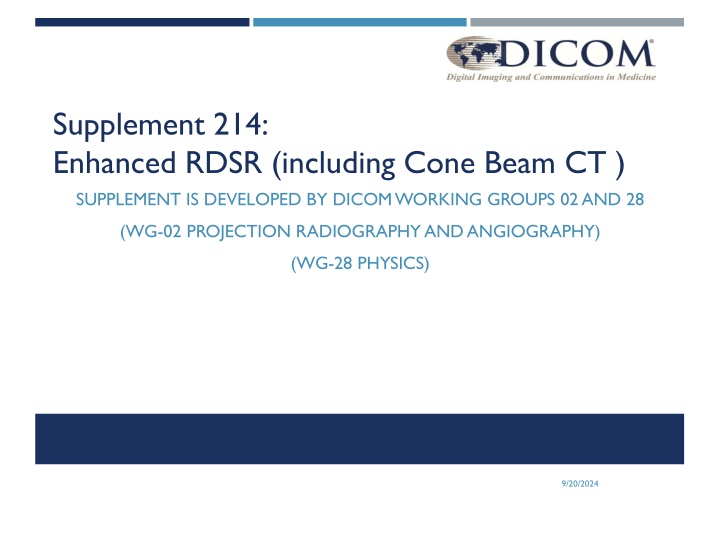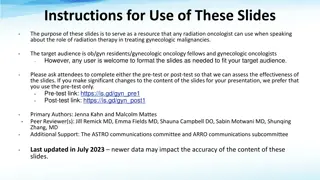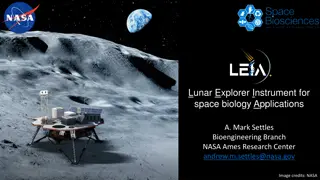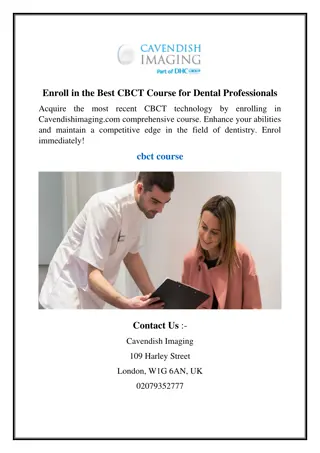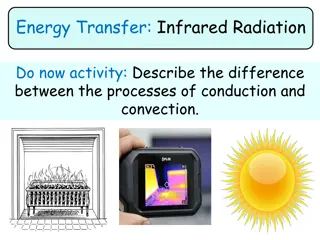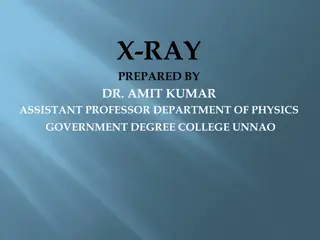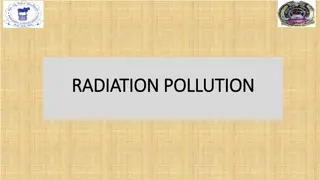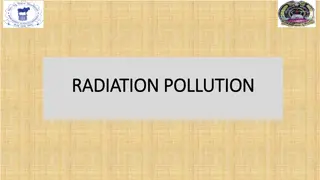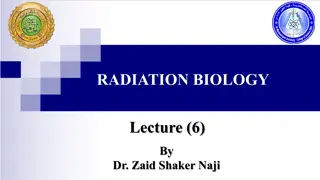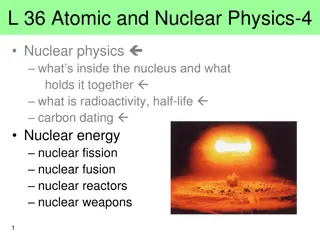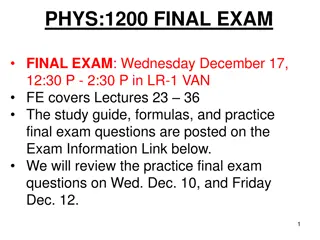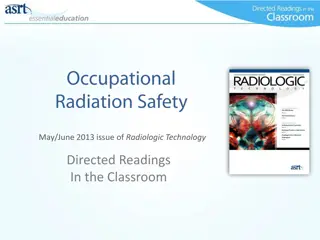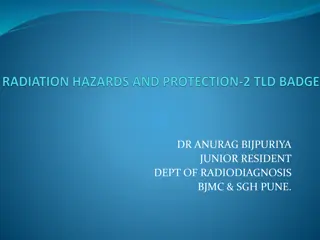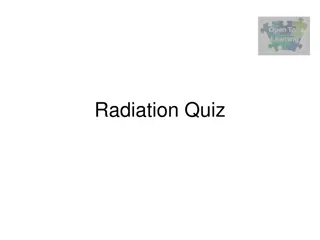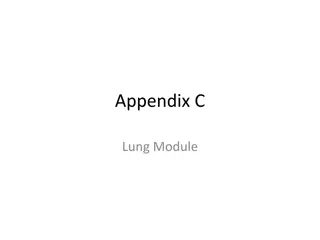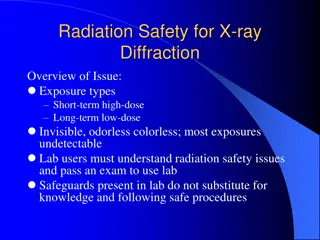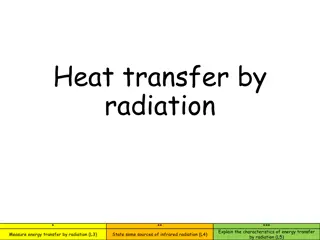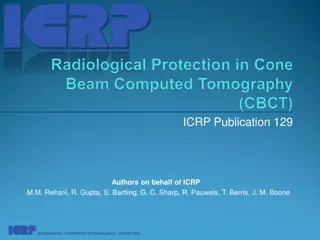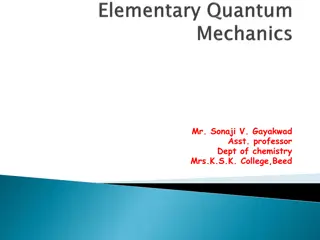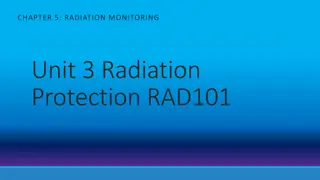Enhanced RDSR for CBCT Radiation Description
Proposal to develop an enhanced Radiation Dose Structured Report (RDSR) for Cone Beam CT (CBCT) imaging, aiming to provide a comprehensive framework for describing CBCT radiation and making the RDSR modality-agnostic. This initiative will streamline the inclusion of modality-specific information, facilitate the adaptation to new technologies, and allow for universal applicability across different imaging modalities.
Download Presentation

Please find below an Image/Link to download the presentation.
The content on the website is provided AS IS for your information and personal use only. It may not be sold, licensed, or shared on other websites without obtaining consent from the author.If you encounter any issues during the download, it is possible that the publisher has removed the file from their server.
You are allowed to download the files provided on this website for personal or commercial use, subject to the condition that they are used lawfully. All files are the property of their respective owners.
The content on the website is provided AS IS for your information and personal use only. It may not be sold, licensed, or shared on other websites without obtaining consent from the author.
E N D
Presentation Transcript
Supplement 214: Enhanced RDSR (including Cone Beam CT ) SUPPLEMENT IS DEVELOPED BY DICOM WORKING GROUPS 02 AND 28 (WG-02 PROJECTION RADIOGRAPHY AND ANGIOGRAPHY) (WG-28 PHYSICS) 9/20/2024 1
Background Provide a framework that will allow for a more complete description of CBCT radiation In addition, much of the irradiation information is universal for all modalities The generation of radiation, filtration, and beam restriction of x-ray systems use similar, and in many instances, identical methods Therefore, the proposal is to create an RDSR that does not require the modality to be defined, and include existing modality-specific information when needed CBCT as a modality with specific requirements remains poorly defined Modalities are evolving, and new hybrid systems may be created Making a modality-agnostic RDSR will reduce or eliminate the need for CPs to accommodate new technology or uses Legacy, regulatory, and other dose information from existing RDSRs can still be included This CBCT RDSR may allow for other modalities to take advantage of this generalizability 9/20/2024 2
Requirements Removes requirement to define characteristics by Irradiation Event Define geometry Use frame of reference (FOR) for complete beam description 9/20/2024 3
Event Timing Current RDSR framework requires parameters to be described per irradiation event Limited methodology for describing parameters beyond an event Proposed RDSR framework describes a begin and end time of parameters Allows for describing radiation-dose-related characteristics of a system in two ways: Dependent solely on irradiation event For each irradiation event, describe the timing and all template content for each irradiation event individually Independent of irradiation events Parameter is characterized by a single value or table of values during specified period of time For characteristics that remain constant (or within some tolerance), create larger time periods that span several irradiation events. For example, if the same technique is used across several irradiation events, the template can encode a single template that indicates a constant technique across events For characteristics that change within an irradiation event, create smaller time periods that describe the changes during the irradiation event For example, a rotating gantry during a CBCT run in XA can have many time windows that describe the position of the gantry. 9/20/2024 4
Event Timing The methodology for beginning/ending the timing associated with a parameter is implementation dependent Wait for a change in the characteristic to meet some threshold Percent change Absolute change Time dependent (every X seconds) By irradiation events All mandatory characteristics must be described completely for the entire time spanned by each irradiation event There may be gaps between descriptions of parameters The information between irradiation events is not relevant for radiation dose purposes. Characteristics may or may not be populated between irradiation events 9/20/2024 5
Timing Example Real World Fluoroscopy DSA DSA CBCT Mode Static Rotating Gantry 1 2 3 4 5 6 7 Pedal Press Sample Encoding t0 tend 1 2 3 4 5 6 7 Irradiation Event Complete Time Period 200 mA 100 mA 200 mA 100 mA 100 mA 500 mA Technique (0,0,10) (-1,0,11) (-2,0,12) (-3,0,11) (-4,0,10) Source Position (0,0,10) (-3,0,9) (-2,0,8) (-1,0,9) 200 mGy 500 mGy Dose Output 2 mGy 2 mGy 1 mGy 1 mGy 2 mGy 2 mGy 1 mGy 1 mGy t
Geometry A complete geometric description of all system components is required for a complete understanding of dose distribution and potential patient impact Describing all components within a reference coordinate system improves downstream users and systems to perform further dosimetry analysis Many radiographic systems have rotating sources Objects in the rotating frame of reference may not move in the rotating frame The proposed supplement uses a transformation matrix to relate a reference coordinate system used by the system to a source coordinate system which may be moving 9/20/2024 7
Geometry +Ys Source - Position (xs, ys, zs) = (0, 0, 0) - Technique factors (potential, current, time) - Focal spot size - Anode material - Inherent filtration +Zs +Xs Os ( ) , , T T T x y z +Xr +Zr Filtration (spectral filters, attenuating filters) - Position (xs, ys, zs) - Dimensions - Material - Thickness Attenuators (e.g., patient support, compression paddle) - Position (xr, yr, zr) - Dimensions - Material - Thickness Oe +Yr RDSR RCS 3.1 3.6 3.2 Radiation Output Information - iAK at Point 2 (xs, ys, zs) 2 3.5 Collimated field - Shape (xs, ys, zs) (Points 3.1-6) 3.3 3.4 8
Transformation Matrix X-Ray Source Transformation Matrix x y z M M M M M M M M M T T T x y z 11 12 13 r x s RDSR Reference RDSR Reference Coordinate Coordinate System ( P r r x y z = Source Source Coordinate Coordinate System System ( P s s x y z = System , r = 12 22 23 r y s ) 31 32 33 r z s ) , , , 1 0 0 0 1 1 r s s Pr Ps +Xs +Zr Oe +Zs +Xr Os +Yr +Ys RDSR RCS 9
Rotating Source Rotating source descriptions can be simplified for many image acquisitions For sources rotating in a plane, a description of initial positioning within the coordinate system, rotation radius, and rotation axis is sufficient to determine future positions and transformation matrices A simplified encoding scheme reduces the burden for implementation and relies on the end user for calculation if desired 9/20/2024 10
Rotating Sources v1 = <0,0,1> COR = <0,-dCOR,0> + DT Center of Rotation v1 DT1 1 DT2 2 dCOR +zr DT3 3 Oe +xr DT4 4 +yr T +xs +zs Os x y z x y z M M M M M M M M M T T T x y z 11 12 13 r s x s +ys = = 12 22 23 r s y s T 31 32 33 r s z s 1 1 0 0 0 1 1 9/20/2024 11
Rotating Sources + + Center of Rotation Center of Rotation v1 v1 dCOR dCOR +xs +zs +xs Os Os +ys +ys 9/20/2024 12
Supplement Structure Creating templates that group related parameters can simplify the encoding methodology and improve usability of the RDSR Items that change together can be updated together in the templates Related positions or machine characteristics are found in the same template 9/20/2024 13
Structure 9/20/2024 14
Notes Promote mandatory technical information that allows the precise definition of needed features of the system, e.g., the whole geometry and characteristics of the X-Ray beam, that are related to dose. Reduce constraints of mandatory summary radiation information. It is the role of regulators, not DICOM, to mandate of the presence of dose information These regulations are evolving (IEC, etc.), country-dependent, and they may mandate different information depending on the category or classification of products within the same modality. Therefore, the manufacturers shall fill the information in the RDSR based on their applicable regulations, case by case. 9/20/2024 15
Author Contacts Nicholas Bevins (editor) nickb@rad.hfh.edu Heinz Blendinger heinz.blendinger@t-online.de Steve Massey steve.massey@pacshealth.com Donald Peck donaldp@mtu.edu Francisco Sureda francisco.sureda@med.ge.com Annalisa Trianni annalisa.trianni@asufc.sanita.fvg.it DICOM Secretariat: dicom@medicalimaging.org 9/20/2024 16
